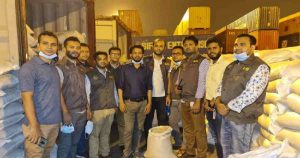Dhaka, July 09 – Four months have passed since the first three Covid-19 cases were detected in Bangladesh but health experts are still divided as to whether coronavirus is going through its peak right now or when it will actually reach its peak. Some experts think the country has already been going through a peak period of the first wave of Covid-19 and it braces for a potential second wave of deadlier outbreak after Eid-ul-Azha.
However, some other experts said Bangladesh is far away from the peak as the infection is still growing alarmingly for inadequacy of preventive measures.
The US’ Johns Hopkins University’s Coronavirus tracker suggests the Covid-19 hit its peak in June in Bangladesh, and the prevalence of the virus here has already begun to decline.
It also included Bangladesh in the list of 20 countries that have flattened the curve of the coronavirus pandemic.
Reviewing the statistics of the last five days’ Covid-19 daily infections in Bangladesh, the university said on Monday that both the infection and the death rates have gone down in the 18th week of transmission of the virus here after reaching a parallel peak during the 14th, 15th, 16th, and 17th weeks.
Dr Abu Jamil Faisel, a member of the public health expert team for the eight divisions formed by the Directorate General of Health Services (DGHS), said Bangladesh has been going through the peak of the first wave of coronavirus outbreak over the last few weeks.
“As per our projection, there would be a month of plateau and the country will witness the similar infection rate for two more weeks and then it’ll start to flatten,” he said.
Dr Faisel, however, warned that the country may witness the second wave of coronavirus outbreak after the Eid if people are allowed to visit cattle markets freely and go to their village homes from cities for celebrating the Eid.
He said their team last week submitted a set of recommendations to the DGHS for preventing the second corona wave and effectively handling the cattle market and Eid vacation trips.
“We suggested encouraging the city dwellers to buy cattle online and preparing their meats under government management. We also recommended disallowing setting up any cattle market in the capital. We also proposed prohibiting anyone from the capital and major cities to go to village homes, and instead encouraging them to avoid mass gathering and crowding, and strictly following health hygiene rules during the Eid,” he said.
Dr Faisel said the second wave is likely to be deadlier than the first one. “People mostly in cities and district towns have been infected with the virus in the first wave. People in rural areas, including Upazilas, unions and villages, will fall victims to the second wave of the virus where case management is difficult as hospitals are not ready and equipped there to handle such patients.”
Prof Be-Nazir Ahmed, former director (disease control) of the Directorate General of Health Services (DGHS) said Bangladesh is far away from the peak, and it is difficult to say when it will reach its peak as the country is going to enter a vicious cycle of infections for lack of any effective preventive measure.
“If you observe the official data given by the DGHS, you can think the transmission is showing a declining trend. It’s because the testing rate has dropped, not the infection rate,” he observed.
Prof Be-Nazir Ahmed said over 4,000 cases were detected when 18,000 samples tested in a day. “But the government is now testing 13,000-14,000 samples and asking the civil surgeons to rein in the tests. If we now test 25,000 samples, we’ll get over 7,000 positive cases. So, we can’t say in any way the transmission of the virus is falling. If we test 20,000 samples and find 3,000 positive cases, only then we’ll be able to say the infection is declining.”
He said the country’s real coronavirus scenario cannot be clearly assumed for lack of adequate tests. “Our testing capacity is very poor. We’ve also seen fake coronavirus test reports were provided by JKG Health Care and Regent Hospital without carrying out any tests. We don’t know whether any other organisation is doing the same thing.”
Dr Be-Nazir lamented that the government could not implement its ‘zoning plan’ even after the Prime Minister’s approval. “Lockdown has been enforced only in two red zones–East Rajabazar and Wari– of Dhaka. When Rajabazar was put under lockdown there’re 29 cases, and later 20 cases were detected. But the fresh infection in the area has now dropped sharply.”
He said the government should enforce lockdown at least in 500 red zones, identify the infected people and isolate them from others to control the virus outbreak.
He warned that the coronavirus situation may take a turn for the worse after the Eid-ul-Azha if the government fails to tackle the situation. “About seven crore people will come to close contact with each other by engaging in cattle buying, sacrificing cattle, processing the meat and distributing it. Besides, many people will go to village homes from cities. So, there’s a possibility that the virus will last for a long time in Bangladesh, and it’s uncertain when it will go to the peak.”
Muzaherul Huq, former regional advisor (South East Asia) of the World Health Organisation (WHO) said the virus is still showing an uptrend and it will continue for at least another month.
He voiced concern as the government has reduced coronavirus tests amid the high infection which is contributing to only worsen the situation.
Huq said a strict lookdown should be enforced across the country for three weeks to slow the virus transmission. “Without adequate tests and strict lockdown, we won’t be able to get rid of the virus in near future,” he added – News desk with UNB




